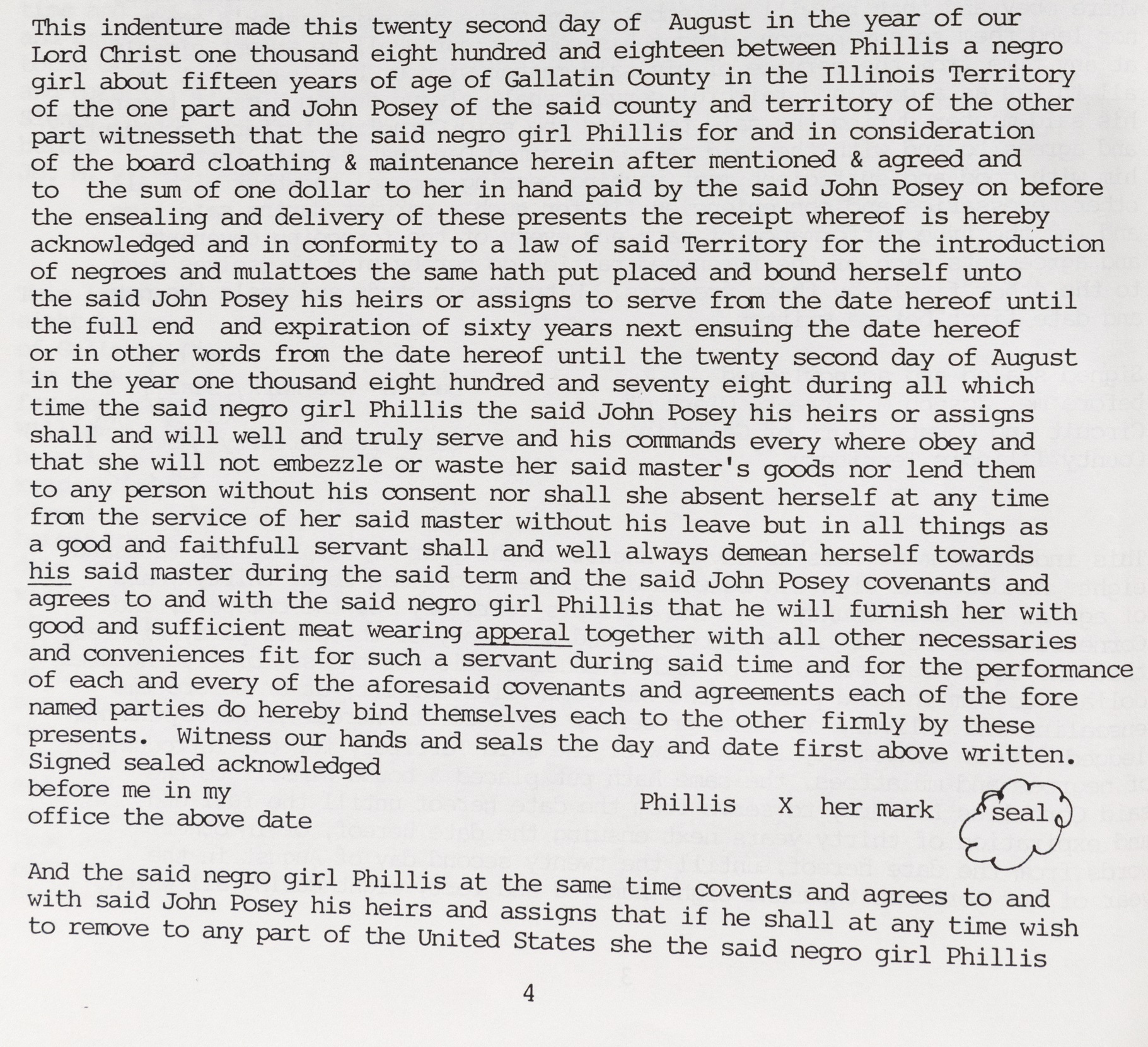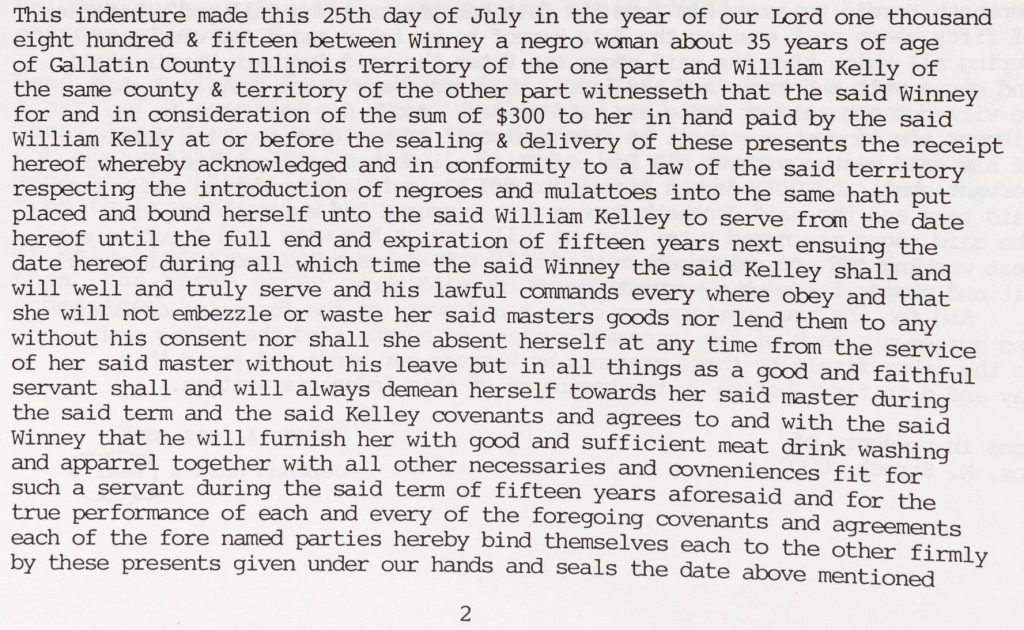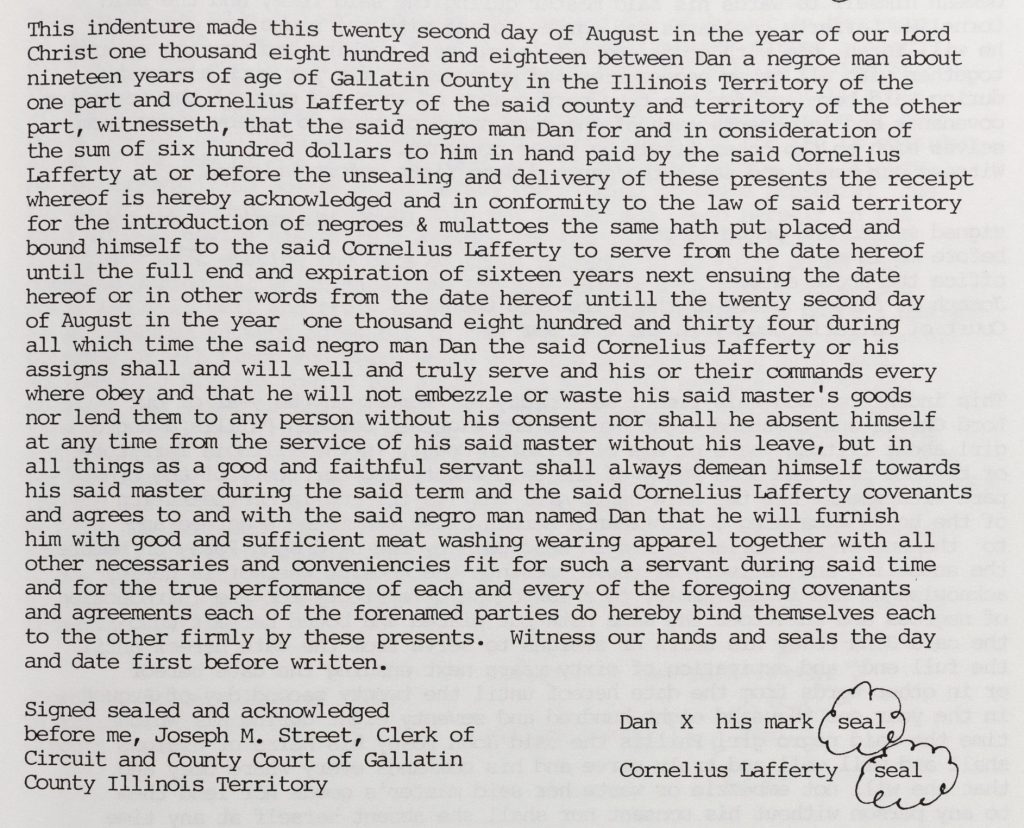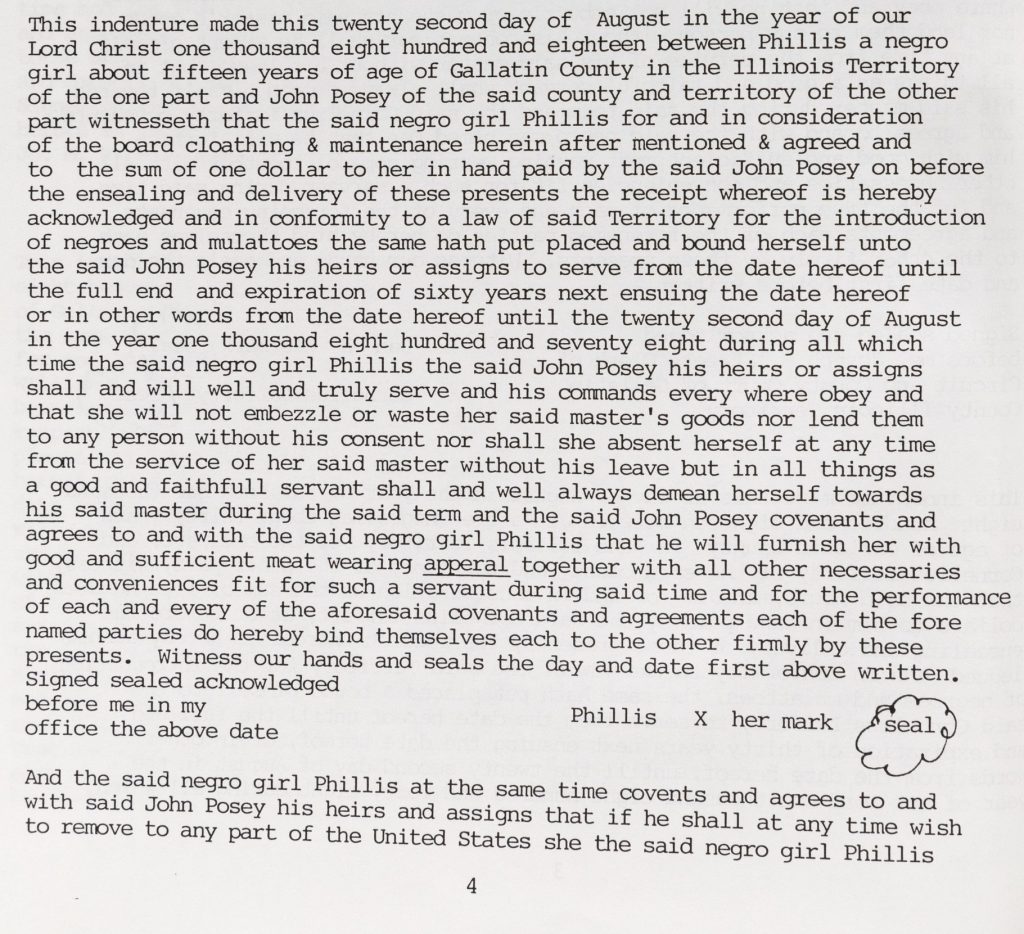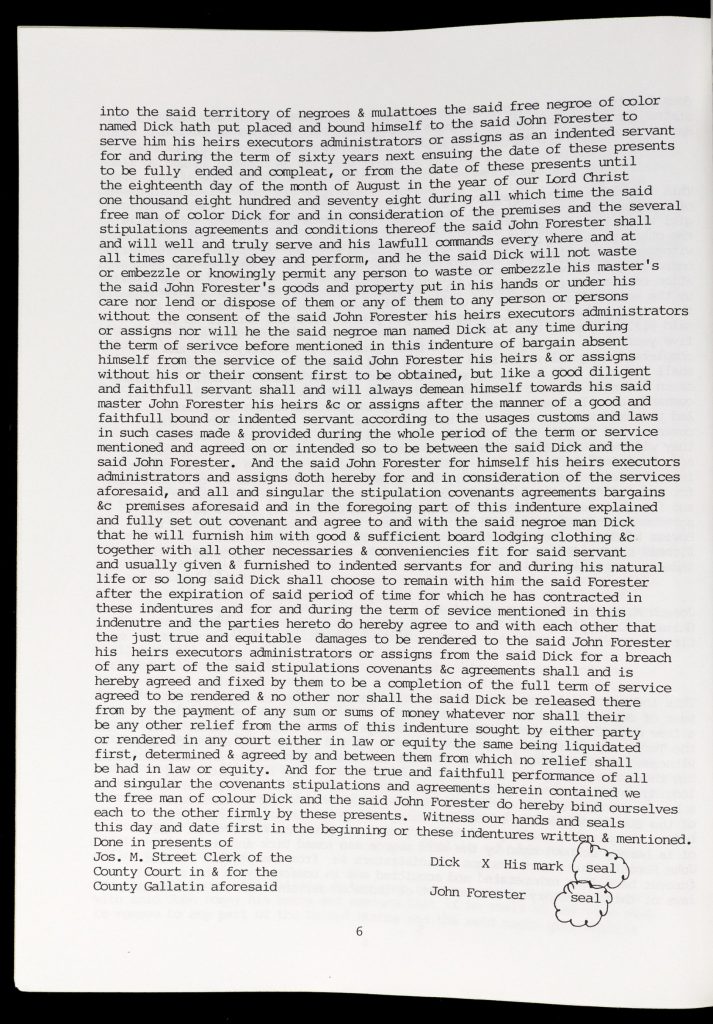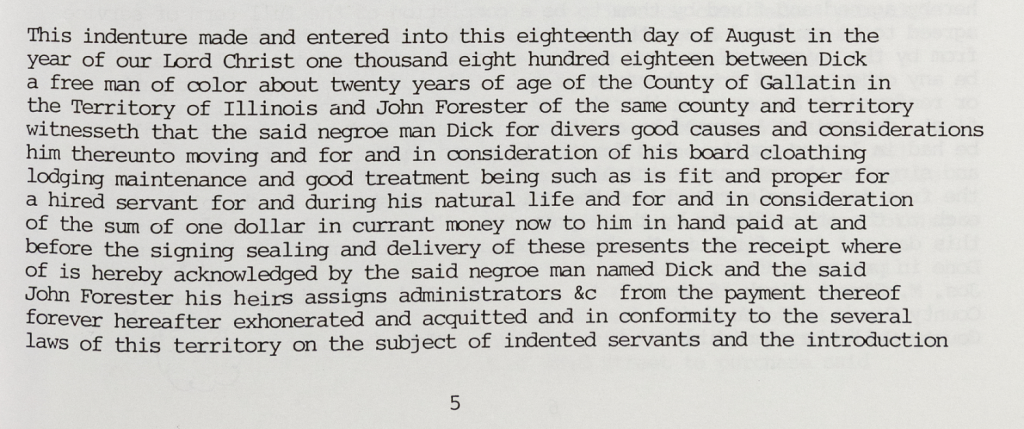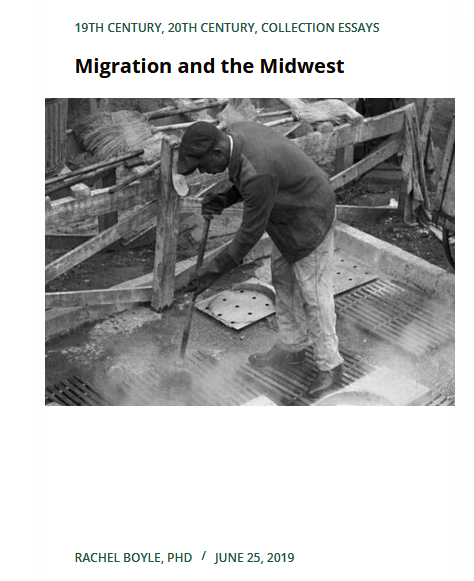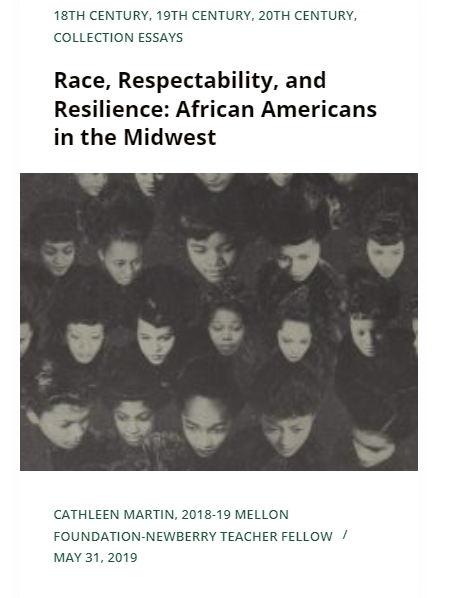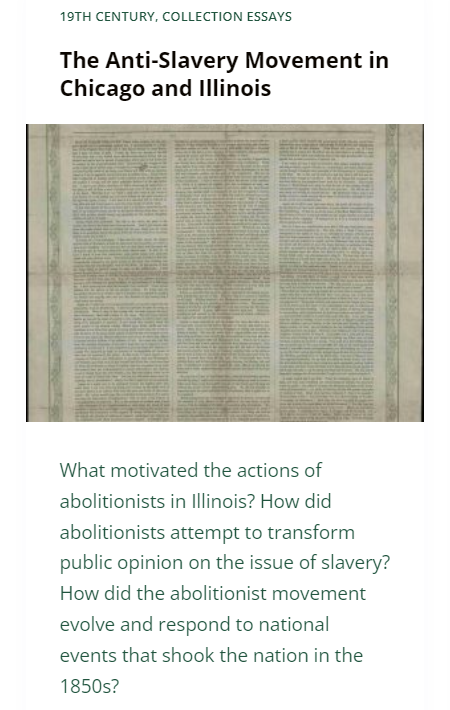Themes
African American History
Enslavement
Illinois History
Northwest Territory
Westward Expansion
Periods
19th Century
Early Republic
Skills & Document Types
Indenture Contracts
Close Reading
Legal Language
Materials – Documents available for download in the Downloads tab.
- Copies of the indenture contracts used in this lesson
- Student worksheets and/or a place for students to record observations
- Optional: Computer and projector
Intro
This lesson explores slavery and freedom for African Americans in Illinois using excerpts from two municipal record books from the territorial period of Illinois history: the Madison County (IL) Book of Records & Indentures 1813-1826 and the Gallatin County, Illinois, Slave Register, 1815-1839.
The lesson is for a teacher-controlled class and is designed for teachers to help students compare and contrast legal documents through a step-by-step inquiry process. Most students will have no or only the barest background knowledge of the subject, so context and background information is provided as part of the lesson flow.
This is a complex lesson for one or even multiple class periods. Alternatively, a quicker introduction to the topic could be given using just the first two sources.
This lesson will give students a view into the complexities of the history of Illinois and of slavery in America, as well as help them develop inquiry skills and provide practice reading, deciphering, and analyzing historic legal records.
Note on Sources
These sources are transcriptions of handwritten municipal record books from the early nineteenth century. At times, they use inconsistent and unusual spellings, noted by “[sic]” in the transcription. For more, see the Skills Lesson: Reading a Transcription. The sources also use legal language and long sentences that might be hard for students to understand. Tactics for reading these sources include:
- Reading sections out loud.
- Working in pairs to decipher the text.
- Summarizing sentences in the margins of the text.
- Crossing out words that don’t directly contribute meaning. These can include legal terms like “aforesaid” and “heretofore,” old-fashioned helping verbs like “doth,” and adverbs like “well and fully.”
- Condensing lists of similar nouns or adjectives. For example, “and the said John Forester his heirs assigns administrators &c” can be read as “John Forester and his heirs” without any loss of meaning.
- Adding commas and periods to the text to break run-on sentences into smaller, easier to understand sections. These contracts often use “and” to connect sentences where we would expect to find a period.
- Reminding students not to worry about words they don’t know. You can often skip words or phrases you don’t understand in dense, legal texts and still understand the overall meaning.
- Color-coding or marking different ideas in the text. For example, using one color or marking for information about what the indentured person agrees to provide and a different color or marking for information about what the “master” agrees to provide.
Using some of these tactics, a student’s copy of a passage from Source 6 might look like this:
Crossed out= language that is redundant or doesn’t directly add meaning- Yellow = comas, sentence breaks, and conjunctions added for ease of reading
- Bold = things John Forester promises to provide to Dick
- Underlined = timeframe of contract

Process
Step One: Sources 1 and 2
The lesson first examines two simple indenture contracts presented without any background information (Sources 1 and 2). Students can make notes about these sources and generate their own questions coming at the sources “cold.” Questions to prompt deeper inquiry and help students examine the texts are provided after the sources. Worksheets with close reading and analysis questions are available for each source in the Downloads tab.
Step Two: Teacher Instruction and Background Information
Provide students with basic background information on the sources and their historical context. After being introduced to the background information, students can reexamine their initial notes and questions, revising and adding information. Additional background information is provided at the end of the lesson.
Step Three: Sources 3-6
Provide one or two sets of additional indenture contracts for students to examine (Sources 3 and 4; Sources 5 and 6). Have students develop their own questions and take their own notes on each set of sources. Alternatively, worksheets with close reading and analysis questions are available for each source in the Downloads tab. Encourage students to incorporate the background information they gained in Step Two into their questions and observations.
Each pair of sources is followed by potential questions to be used as necessary to help students examine the sources deeply. Note that Sources 5 and 6 are longer and more complex than Sources 3 and 4.
More advanced students could work individually or in small groups rather than being led by the teacher, examining each document and making notes in the worksheets provided.
Display or Distribute Sources 1 and 2
- Source 1: Maddison County records, page 97. Contract between Sarah and John Wallace.
- Source 2: Maddison County records, page 109. Contract between Janet and Joseph Conway.
Students can work alone, in pairs/groups, or together as a class. Give students time to read through the sources, pull out important information, and generate their own questions. Use the source analysis worksheets if useful.
Potential Analysis and Inquiry Questions
- When were these sources created? (January & February 1818)
- Where were they created? (Madison County, Illinois Territory)
- Who are the people involved? (John Wallace, Sarah, Joseph Conway, Janet and Edmund Randle)
- What kind of document is this? (a legal agreement; an indenture agreement)
- Who is Edmund Randle? (Deputy Clerk of the County Court)
- What is the relationship between the parties in each source? (indenture or servant and holder of the indenture or ‘master’)
- How is Sarah described? (as a 19-year-old Black woman recently brought to Illinois from another territory)
- How is Janet described? (as a 15-year-old Black boy who had been enslaved in Kentucky)
- According to the sources, did Sarah and Janet enter into these contracts willingly? (Sarah is described as “agreeing with” the indenture. Janet is described as voluntarily agreeing, but the contract also says he was enslaved in Kentucky.)
- How long is each indenture? (Sarah’s is 90 years. Janet’s is 30 years.)
- How old will Sarah be when her indenture is over? How old will Janet be when his indenture is over? (Sarah will be 109; Janet will be 45.)
- How are John Wallace and Joseph Conway described? What word is used? What does that word make you think of? (They are both described as a ‘master.’ This word brings to mind slavery. Remind students that the term master was also used in European indenture and apprenticeship agreements.)
- Do you think Janet and Sarah entered into these contracts willingly? Why or why not? (Answers will vary.)
- Why might John Wallace and Jospeh Conway have wanted to formally indenture Sarah and Janet? Why were Sarah and Janet indentured rather than being formally enslaved? (because slavery was illegal in Illinois territory)
- Does anything about these sources surprise you?
- What do you not know about the background relating to these sources? What questions do you have? Where could you find answers to your questions?
Teacher Instruction and Background Information
Before reviewing the next sources, provide students with some or all of the information in the Background section. Utilize whatever instruction method works best for your students.
Once students have more background, revisit their initial questions and observations. Ask:
- Does this information change whether or not you think Sarah and Janet voluntarily agreed to their contracts? Why or why not?
- Does this information answer any of the questions you asked about the source? Does it make you want to revise any of those questions?
- Does it raise any new questions?
Explain to students that they will be reading more sources of the same type from two counties in Illinois.
Display or Distribute Sources 3 and 4
- Source 3: Gallatin County, pages 2. Contract between Winney and William Kelly (Signatures page 3).
- Source 4: Gallatin County, page 3. Contract between Dan and Cornelius Lafferty.
Students can work alone, in pairs/groups, or together as a class. Give students time to read through the sources, pull out important information, and generate their own questions. Use the source analysis worksheets if useful.
Potential Analysis and Inquiry Questions
- When were these sources created? (July 25, 1815 and August 22, 1818)
- Where were they created? (Gallatin County, Illinois)
- Who are the people involved? (Winney, William Kelly, Dan, Cornelius Lafferty)
- How are they described? (Winney is “a negro woman about 35 years of age.” Dan is “a negroe man about nineteen years of age.” Kelly and Lafferty are also described as “masters.”)
- What are the main terms of these contracts, i.e., What is William Kelly promising to provide Winney and what is Winney promising in return? What is Cornelius Lafferty promising to provide Dan and what is Dan promising in return? (The main terms are that Winnie and Dan will work as servants and obey Kelly and Lafferty in all ways for a specific period of years in exchange for their basic necessities to survive and a specified sum of money.)
- How long is Winney’s indenture and how much money will she receive in exchange? (15 years; $300)
- How long is Dan’s indenture and how much money will he receive in exchange? (16 years; $600)
- How does this compare with Sarah and Janet’s indentures? What are some similarities and what are some differences? (Both sets of indentures are between a white person and a Black person, but Winney and Dan’s indentures are much shorter, provide both Winney and Dan money at the end of their terms, and are much more detailed about what each party owes the other.)
- Do you think Dan and Winney entered into these contracts willingly? Why or why not? (Answers will vary, but students might point to the shorter term of the indentures and the money paid at the end of them to argue that these indentures were more likely to have been entered into willingly.)
- What do the contracts mean by “the law of said territory respecting the introduction of negroes and mulattoes to the same”? How could you find more details about this law? (Help students decode the quoted phrase, remind them of the background material provided, and lead them to the surmise that there was a law on the books in both 1815 and 1818 that limited the immigration of free Black people to Illinois. Students can use that phrase in a Google search to find out more information. The Madison County (Illinois) Historical Society has a good page about Slavery and the Law in Illinois.)
- Do these sources answer any of your questions? Do they inspire new questions?
- Does anything about these sources surprise you?
- What do you not know about the background relating to these sources? What questions do you have? Where could you find answers to your questions?
Display or Distribute Sources 5 and 6
- Source 5: Gallatin County, pages 4-5. Contract between Phillis and John Posey.
- Source 6: Gallatin County, pages 5-6. Contract between Dick and John Forester.
Students can work alone, in pairs/groups, or together as a class. Give students time to read through the sources, pull out important information, and generate their own questions. Use the source analysis worksheets if useful.
Potential Analysis and Inquiry Questions
- When were these sources created? (August 22, 1818 and August 18, 1818)
- Where were they created? (Gallatin County, Illinois)
- How old are Phillis and Dick and how are they described? (Phillis is described as a negro girl who is 15 years old. Dick is described as a “free man of color” and as a negro man. He is 20 years old.)
- How long is Phillis’s indenture and how much will she receive in exchange? (Phillis will receive $1 in exchange for 60 years’ service.)
- How long is Dick’s indenture and how much will he receive in exchange? (Dan will receive $1 in exchange for 60 years’ service.)
- How is Dick described in this record? (as a free man of color) Is this detail important? Why or why not? (This contact explicitly states that Dan was a free person when he entered the contract, where other indentures in the lesson did not.)
- How old will Phillis and Dick be when their indentures are completed? (Phillis, 75 years old; Dick, 80 years old)
- Do you think Phillis and Dick entered into these contracts willingly? Why or why not? (Answers will vary. Some students may point out that Black people in Illinois had very few choices, so the term “willingly” might not be strictly applicable. Others might wonder what could have caused Dan, a free man, to enter into such a contract, especially considering the detail that no one could ever buy him out of it.)
- How do these indentures compare with Winney and Dan’s and Sarah and Janet’s? (These indentures are much more detailed, especially than Sarah and Janet’s. They include more details about how bound Phillis and Dick are to their “masters,” for example that Phillis must travel with Posey anywhere in the US and Dick cannot buy his freedom from the indenture.)
- How is Phillis’ indenture contract different from all the others you have read? What detail does John Posey enforce on Phillis after the main indenture contract? (Phillis’s indenture includes that Posey can take Phillis to any part of the United States and she must go with him and remain indentured to him.)
- How is Dick’s indenture contract different from all the others you have read?
Can Dick ever buy his own freedom, have anyone else buy his own freedom, or be manumitted? (Dick’s indenture specifies that he can never be released from the indenture, no matter what. This is the first time this kind of detail has been included in any indenture students’ have seen, and might strike them as particularly onerous and vicious,) - Do you think Phillis and Dick were freed by the Civil War, or not? Why or why not? (Answers will vary.)
- What do the contracts mean by “the law of said territory respecting the introduction of negroes and mulattoes to the same”? How could you find more details about this law? (Help students decode the quoted phrase, remind them of the background material provided, and lead them to the surmise that there was a law on the books in both 1815 and 1818 that limited the immigration of free Black people to Illinois. Students can use that phrase in a Google search to find out more information. The Madison County (Illinois) Historical Society has a good page about Slavery and the Law in Illinois.)
- Does this source answer any of your earlier questions?
- Does anything about these sources surprise you?
- What do you not know about the background relating to these sources? What questions do you have? Where could you find answers to your questions?
Final Questions
- Compare and contrast the first, second, and third set of indentures: How are they similar and how are they different?
- Why were these indentures created?
- Was there slavery in Illinois in the territorial and early statehood period? Why or why not?
- Were slavery and indenture the same in Illinois? If not, why not? If so, how?
- Did Black people enter into indenture contracts willingly? Why or why not?
What were some reasons Black people might commit to an indenture? - How could you find out more about the Black people mentioned in these sources?
- Discuss with students what element of the lesson most captured their interest. Were all their questions answered? Where could they find information for their unanswered questions? What new information would they like to discover? Where could they look to find that information?
Background
Starting from the eras of French domination, slavery became a deep part of the economy and development of what is now southern Illinois. Both French and early American residents enslaved people and paid taxes on them.
What is now Illinois was part of the Northwest Ordinance of 1787, which outlawed slavery in the Northwest Territory (roughly what is now Ohio, Indiana, Illinois, Michigan, Wisconsin, and part of Minnesota). Arthur St. Clair, the territorial governor, interpreted this to mean that no new enslaved people could be brought into the territory, but that enslaved people already living in the territory would remain legally enslaved.
Illinois became part of Indiana Territory in 1800. Indiana Territory laws outlawed enslavement but allowed for “voluntary” indentured servitude. White citizens of the Indiana Territory bent these laws to enslave people. They traveled to slave states and returned with an enslaved person, who was then “voluntarily” indentured. If the person did not agree to the indenture, they could be sold back into official slavery to the south. African Americans under 15 years old were automatically indentured for 20 years. Holders of indentures could sell or trade indenture contracts, effectively selling or trading the indentured person.
The constitution for the State of Illinois was adopted on August 26, 1818, and Illinois officially became a state on December 3, 1818. Under the new state constitution, indentures were supposed to be limited to one year, however, the lengths of all indentures made before statehood remained in force. People enslaved in Illinois before 1787 and their children remained enslaved.
By 1810, 781 African Americans lived in the Illinois Territory: 168 were enslaved, and 613 were free. By 1818, at the time of statehood, 1,173 African Americans lived in the Illinois Territory: 847 were servants or enslaved, and 326 were free.
After statehood, threats to Black freedom continued. In 1819, the state legislature passed “black codes” or “black laws,” laws that governed the movements and legal status of all Black residents of Illinois. The laws required free Black residents to register with local government and provide documentation proving their freedom. Black residents who could not prove their freedom could be arrested and sold into forced labor for one year.
In 1824, statewide legal enslavement almost returned to Illinois until voters defeated an attempt to change the state constitution to allow it. In 1855, “Logan’s Black Law” was passed, which limited the rights of free Blacks and threatened Black immigrants with indentured servitude.
Madison County is currently located in the southern part of the Illinois, but in 1812, it reached from southwestern Illinois all the way up to the Canadian border. Gallatin County was and still is a small county in southeastern Illinois.
Extension Activities
Students might want to explore more of the history of southern Illinois, find out if other states also used this indenture system to get around anti-slavery laws, or research more people who were indentured.
Illinois emancipation and indenture records are searchable online via the Illinois State Archives’ Illinois Servitude and Emancipation Records. Have students search these records, or read more of the Maddison County indenture contracts. Ask students to compare what they find in these sources with the ones they analyzed in this lesson.
It is very difficult to find information about the Black people mentioned in these indenture records in the US census. A few of the white people mentioned in the lesson can be found in the 1820s and 1830 US Census, though, which only lists heads of households. Interestingly, none of them list having a free person of color in their households but have enslaved people who match the ages of the indentured people in the documents above. For example, Cornelius Lafferty appears in the 1820 census, and there is an enslaved person in his household who is Dan’s age.
Here is the census page and a transcription of the information about Lafferty’s household. (Download the images by right clicking and selecting “Save Image.”)
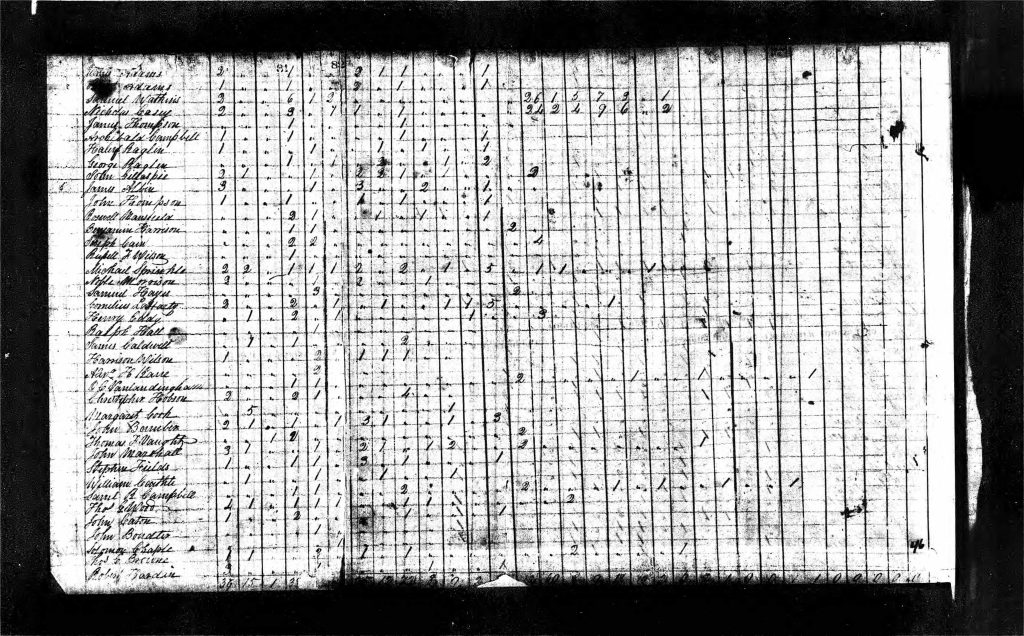

Ask students to analyze the information above. What does it tell you about Lafferty’s family? Does it give you any new context for Dan’s contract or any of the other contracts?
Search for the other white people named in the contracts in the 1820 and 1830 censuses and discuss the information you find.
Words to Know
&c | abbreviation for “et cetera”
Indenture │ a contract binding one person to work for another for a set period of time
Manumission | formal emancipation from / freedom from slavery
Illinois Social Science Standards
This lesson supports the following standards from the Illinois Learning Standards for Social Science:
Developing Questions and Planning Inquiries: SS.6-8.IS.1.MdC: Ask essential and focused questions that consider multiple perspectives and will lead to independent research.
Evaluating Sources and Using Evidence: SS.6-8.IS.2.MdC: Determine the credibility of sources based on their origin, authority, and context.
History:
- SS.6-8.H.3.MdC: Detect possible biases and limitations in the historical record based on evidence collected from different kinds of historical sources by identifying the author, purpose, funding/source, type of publication/outlet, intended audience, etc.
- SS.6-8.H.2.MC: Evaluate how perspectives of multiple individuals and groups have impacted the availability of information and the creation of historical sources.
- SS.9-12.H.7: Identify and analyze the role of individuals, groups, and institutions in people’s struggle for safety, freedom, equality, and justice.
- SS.9-12.H.10: Identify and analyze ways in which marginalized communities are represented in historical sources and seek out sources created by historically oppressed peoples.
Common Core
This lesson supports the following Common Core Literacy in History/Social Science standards:
English Language Arts: History/Social Studies
- CCSS.ELA-LITERACY.RH.6-8.2: Determine the central ideas or information of a primary or secondary source; provide an accurate summary of the source distinct from prior knowledge or opinions.
- CCSS.ELA-LITERACY.RH.6-8.4: Determine the meaning of words and phrases as they are used in a text, including vocabulary specific to domains related to history/social studies.
- CCSS.ELA-LITERACY.RH.6-8.6: Identify aspects of a text that reveal an author’s point of view or purpose (e.g. loaded language, inclusion or avoidance of particular facts).
- CCSS.ELA-LITERACY.RH.9-10.1: Cite specific textual evidence to support analysis of primary and secondary sources, attending to such features as the date and the origin of the information.
- CCSS.ELA-LITERACY.RH.9-10.4: Determine the meaning of words and phrases as they are used in a text, including vocabulary describing political, social, or economic aspects of history/social science.
Download the following materials below:
- A copy of the lesson “Indenture and Enslavement in Illinois”
- Transcriptions of the sources used in this lesson
- Student worksheets for all sources
Related Newberry Resources
Additional Resources
- “The Story of Illinois,” Illinois State Museum
- “Black Life in Antebellum Illinois: Slavery and Racist Laws,” The Colored Conventions Project.
- ”Chronology of Illinois History,” Illinois Blue Book, Illinois Secretary of State
- Madison Historical: The Online Encyclopedia and Digital Archive of Madison County, Illinois



